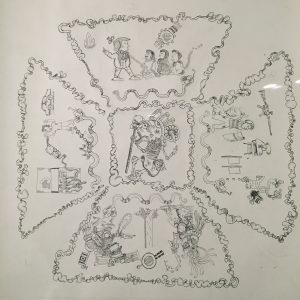

The multimedia aspect of Hughes’ artworks is demonstrated as collage with written text, which adds a transformative fluid meaning. The artist uses text to evoke the viewer’s emotions; he wishes to “create a new vernacular” by transforming the original meaning of the text into his new desired meaning.


Painting on dried grub worms


Within his multimedia painting “The Space between the Living and Dead,” Hughes uses torn pieces of obituaries and string to convey the idea of boundaries between the two realms. He believes the space is thin between the living and the dead and that crossing over is inherently easy
Nathan Hughes’ multimedia painting “The Space between the Living and Dead” is currently showcased at the 33rd Annual Juried Student Exhibition located within the Main Art Gallery on UTSA’s Main Campus.


The artist uses her works to comment on the sociopolitical concerns between two neighboring countries: Mexico and the United States. She hopes to inform and persuade her audience to be engaged in these pertinent issues.
When creating her codex inspired piece “La Muerte,” Escobar-Cotera was influenced by her grandfather, a codex enthusiast.




“I learned about this after I started creating my own codices, and it pushed me to continue my work; in a way also bringing me closer to him,” said Escobar-Cotera.
“La Muerte” is used as a medium for the artist to critique contemporary society, politics and economics by comparing these issues to those of the Aztec civilization.
“I’m interested in exploring political narrative through a historical context, making connections between the past and the present,” said Escobar-Cotera. “Through this connection, we find that these issues are recurring.”
More of Paulina Escobar-Cotera’s artworks can be viewed on her website paulinaescobar.com.
Derek Schneeberger focuses his paintings on his personal and emotional reflections.
“One can feel an artist’s passion or anger through the construction of the piece, and those feelings can resonate with the viewer,” said Schneeberger. “Things such as a passion for painting or the anger from a familial dispute are normal moments in life that I wish for the viewer to understand.”
Schneeberger conveys many relatable emotions within his works, but the feeling he expresses the most is stress, which he has suppressed since his youth. He believes stress is the emotional origin which leads him to a spectrum of various emotions.
The artist uses three elements to create his artworks: shape, line and color.
“The shapes within my pieces correspond with the emotional status I currently feel,” said Schneeberger. “Lines within the background represent misguided directions and spontaneous compulsions, while the foreground lines and shapes represent direction and order. Finally, color is connected to the emotional status.”




Schneeberger creates his artworks in the moment of inspiration. He does not know what his paintings will be until they are finished.


Talamantez focuses on the subject matter of nature and the human body; the artist has always been interested in the human body, but he is now “admiring it and not trying to understand it.”
The piece “Self-Contained” focuses on the human body, but the meaning of the piece is not physical admiration. Talamantez uses the piece as a way to portray the boundaries we establish for ourselves, and how we conform to a social mold that is difficult to break from.
Talamantez was involved in a solo show at the Brick at Blue Star Arts Complex, which included his piece “El Tejas.” The entire show conveyed the idea that we as individuals see the world in a very digital way. The artist wanted to express this idea, while making his experience in downtown San Antonio physical rather than just a cherished mental experience.











